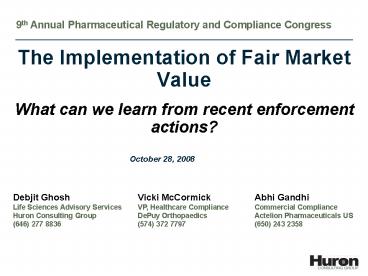The Implementation of Fair Market Value PowerPoint PPT Presentation
Title: The Implementation of Fair Market Value
1
9th Annual Pharmaceutical Regulatory and
Compliance Congress
- The Implementation of Fair Market Value
- What can we learn from recent enforcement actions?
October 28, 2008
Debjit Ghosh Life Sciences Advisory
Services Huron Consulting Group (646) 277 8836
Vicki McCormick VP, Healthcare Compliance DePuy
Orthopaedics (574) 372 7797
Abhi Gandhi Commercial Compliance Actelion
Pharmaceuticals US (650) 243 2358
2
Todays Discussion Agenda
- Background on fair market value
- Where fair market value can impact our business
- Discussion of recent investigations
- Developing a fair market value process
- Determining fair market value for programs and
services - Implementation considerations
3
Regulatory Background
- Relationships with healthcare professionals and
healthcare organizations are under significant
scrutiny by regulators at both the Federal and
State levels. - Key concern is providing items of value
(compensation, gifts, hospitality, etc.) and the
ability of those items of value to influence
medical decision making. - Several States have passed laws requiring
manufacturers to track what is being provided to
healthcare professionals and MN prohibits gifts
to healthcare professionals greater than 50 in a
year. - There is Federal legislation pending to require
pharmaceutical manufacturers to track and
disclose spending on healthcare professionals as
part of a national registry. - There were 5 Deferred Prosecution Agreements in
2007 with Medical Device Companies focused almost
entirely on their relationships with healthcare
professionals.
4
Focus of the Recent Device Matters
- Demonstrating the need for the service
- How did the company determine the overall number
of service activities that were needed? - How was the determination made of how many HCPs
are needed to provide the service? - How was the determination of the individual HCP
made to provide the service? - Justifying the appropriateness of the payment
level - What was the HCP compensated to provide the
service? - What factors were considered in compensating for
the service? - How were those factors validated?
5
Where can FMV Impact our Business
Clinical Research
Medical Affairs
Sales Marketing
Commercial Contracting
- Clinical trial payments
- Consulting payments
- Protocol development
- Royalty payments
- Advisory board payments
- Consulting payments
- Publications
- Conferences
- Advisory board payments
- Consulting payments
- Promotional speaking
- Market research
- Service fee payments
- Wholesalers/Distributors
- GPOs/MCOs
- Specialty Pharmacy
- Managed care ad boards
- The FMV touch-points are throughout the company
- Compensation levels for a similar level of effort
should be harmonized across the functional areas
of a company - Regulators are asking for fair market value
analysis for all areas of the company
6
Demonstrating Need is Critical
- How did the company determine the overall number
of service activities that were needed? - What was the rationale for the number of
consultant meetings, advisory boards, and other
activities involving HCPs - Benchmarking historical levels of activities may
be one data point however, it is generally not
sufficient on a stand alone basis - Could a bottom-up forecast of services be
developed of each service activity by
brand/product group and functional area? - How was the determination made of how many HCPs
are needed to provide the service? - What was the basis for the total number of
service activities and the frequency of each
individual activity - Promotional meetings, advisory boards,
consultant services, etc. - How was the determination of the individual HCP
made to provide the service?
7
Managing Need Against Budget
- Highly sensitive area of discussion for the
Government - Services should be driven by business need and
not availability of budget funds - Budget parameters should be a data point in the
decision making process, but not the primary data
point - The services should be identified by a
bottom-up estimate of need by functional area
and strategic objective - The bottom-up need should then be managed
against any budget parameters
8
The Structure Used in the DPA Environment
Articulation of Strategic Objectives
Development of Tactical Initiatives
Define Number of Services
Define Number of HCPs
Compliance Committee
Budgeting
Summarization
Harmonization with Budget Constraints
Executive Level Review
- Cross-Functional compliance committee
- Articulation of strategic objectives
- Development of tactics
- Executive review and budget harmonization
9
Justifying the Appropriateness of the Payment
- What was the HCP compensated to provide the
service? - Does the company have a standard rate schedule
- How was that developed
- Is it used company-wide or only for certain
functional areas - What factors were considered in compensating for
the service? - HCP specialty
- HCP stature
- Level of effort
- Level of intensity
- Deriving an hourly rate
- How were those factors validated?
10
Implementation Considerations for FMV
- Managing budget constraints across different
functional areas that may yield varying payment
levels - Sales Marketing
- Clinical Research
- Medical Affairs
- Professional Education
- HCPs may have a perceived value of certain
services and may be willing to accept a lower
level of payment - Downstream clinical or medical value
- Support for medical education and the medical
mission
11
Key Take Away Points
- Companies should consider developing a
cross-functional team to review requests for HCP
services. - The service requests should have some
documentation of strategic objective and business
need. - Implementation of an FMV schedule should consider
the contracting needs of all functional areas to
ensure harmonization of payment. - Gaining buy-in from the key stakeholder is
critical to building a successful and sustainable
process. - Consider developing a guidelines document.
12
L I F E S C I E N C E S A D V I S O R Y S E
R V I C E S

